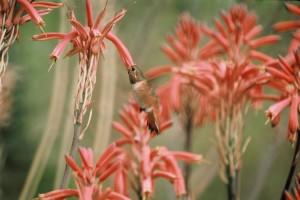Allen's Hummingbird courtesy USFWS
More and more North Carolina bird enthusiasts are leaving their hummingbird feeders up yearround with the hope of attracting a hummingbird that has decided to spend the winter in NC, rather than traveling south.
Since November, an Allen's Hummingbird, a western species that normally winters in Mexico, has been seen at Riverbend Park in Catawba County. Birders have been flocking to this site on the NC Birding Trail to see the bird; this is only the second recorded sighting of the species in North Carolina. On Sunday, December 4, Dwayne Martin, a ranger at the park, posted an update on the bird on the Carolinabirds listserv:
"The Allen's Hummingbird is still being seen at Riverbend Park,
however, he has become a little more unpredictable between 11:00am and
2:00pm. Between those hours he may only visit the feeder once or
twice. Please be patient. He will likely show up at some point.
Before 11 am and after 2 pm, he is pretty regular at the feeder and in
the blackberries beside the office. Also, we will make every effort
for someone to be in the office to show folks where he is being seen.
If, however, you get there and no one is in the office, please observe
the bird from a distance outside of the office. Please do not go to
the picnic table near the feeder. He will not show if you do that.
He is still very skittish of people."
The Carolina Bird Club website offers some helpful info about these hummingbirds: To date ten species of hummingbird have been documented while visiting North Carolina during the non-breeding season. But identification of these birds is difficult since most are nondescript females or juveniles. They tend to look very similar; their identity is often based on color, shape or size of just a few feathers.
The early view that hummingbird feeders left hanging in the fall deter Ruby-throateds from migrating is false. These tiny marvels begin to head south as early as late July due to hormonal changes when the days begin to shorten. Neither food supply nor the weather has any effect on their behavior. Therefore feeders left up can only help late migrants or supplement the diet of winter visitors. Although hummingbirds in general eat mainly small insects, nectar is a significant component of their diet year round.
No special care is required for these hardy winter hummingbirds. The birds will appreciate a feeder with the usual 4:1 (water: sugar) nectar solution. The solution will not freeze unless the air temperature around the feeder drops below 27 degrees F. Most days during the winter this will not be a problem. And on colder nights, the feeder can be taken indoors at dark since hummers do not feed at night. Due to slower fermentation rates during cooler weather, the feeder should only need cleaning and refilling about once every two weeks.
If you live within a half mile of a wet area (lake, river, stream, pond or even a golf course water hazard), your chances of attracting a winter hummer are quite good. Just be sure your feeder is hung so that you can monitor it easily—especially early in the day when hummingbirds are most active.
Please contact hummingbird researcher Susan Campbell if you see or hear about a hummingbird between November 1 and March 15. Susan is an affiliate with the NC Museum of Natural Sciences who is studying and documenting these individuals. She can be reached at 910-585-0574 or susan@ncaves.com.
You can learn more about the hummingbird research at the Museum of Natural Sciences website.
-- Ida Phillips




